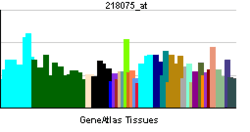AAAS (gene)
Aladin also known as adracalin is a protein that in humans is encoded by the AAAS gene [achalasia, adrenocortical insufficiency, alacrimia (Allgrove, triple-A)].[1]
Function
Aladin is a component of the nuclear pore complex.[2][3]
Clinical significance
Mutations in the AAAS gene are responsible for Triple A syndrome (also known as Allgrove Syndrome).[4]
References
- ↑ Tullio-Pelet A, Salomon R, Hadj-Rabia S, Mugnier C, de Laet MH, Chaouachi B, Bakiri F, Brottier P, Cattolico L, Penet C, Bégeot M, Naville D, Nicolino M, Chaussain JL, Weissenbach J, Munnich A, Lyonnet S (November 2000). "Mutant WD-repeat protein in triple-A syndrome". Nat. Genet. 26 (3): 332–5. doi:10.1038/81642. PMID 11062474.
- ↑ Kind B, Koehler K, Lorenz M, Huebner A (December 2009). "The nuclear pore complex protein ALADIN is anchored via NDC1 but not via POM121 and GP210 in the nuclear envelope". Biochem. Biophys. Res. Commun. 390 (2): 205–10. doi:10.1016/j.bbrc.2009.09.080. PMID 19782045.
- ↑ Cho AR, Yang KJ, Bae Y, Bahk YY, Kim E, Lee H, Kim JK, Park W, Rhim H, Choi SY, Imanaka T, Moon S, Yoon J, Yoon SK (June 2009). "Tissue-specific expression and subcellular localization of ALADIN, the absence of which causes human triple A syndrome". Experimental & Molecular Medicine 41 (6): 381–6. doi:10.3858/emm.2009.41.6.043. PMC 2705858. PMID 19322026.
- ↑ "Entrez Gene: AAAS achalasia, adrenocortical insufficiency, alacrimia (Allgrove, triple-A)".
Further reading
- Maruyama K, Sugano S (1994). "Oligo-capping: a simple method to replace the cap structure of eukaryotic mRNAs with oligoribonucleotides.". Gene 138 (1–2): 171–4. doi:10.1016/0378-1119(94)90802-8. PMID 8125298.
- Weber A, Wienker TF, Jung M et al. (1997). "Linkage of the gene for the triple A syndrome to chromosome 12q13 near the type II keratin gene cluster". Hum. Mol. Genet. 5 (12): 2061–6. doi:10.1093/hmg/5.12.2061. PMID 8968764.
- Suzuki Y, Yoshitomo-Nakagawa K, Maruyama K et al. (1997). "Construction and characterization of a full length-enriched and a 5'-end-enriched cDNA library". Gene 200 (1–2): 149–56. doi:10.1016/S0378-1119(97)00411-3. PMID 9373149.
- Handschug K, Sperling S, Yoon SJ et al. (2001). "Triple A syndrome is caused by mutations in AAAS, a new WD-repeat protein gene". Hum. Mol. Genet. 10 (3): 283–90. doi:10.1093/hmg/10.3.283. PMID 11159947.
- Sandrini F, Farmakidis C, Kirschner LS et al. (2001). "Spectrum of mutations of the AAAS gene in Allgrove syndrome: lack of mutations in six kindreds with isolated resistance to corticotropin". J. Clin. Endocrinol. Metab. 86 (11): 5433–7. doi:10.1210/jc.86.11.5433. PMID 11701718.
- Schmittmann-Ohters K, Huebner A, Richter-Unruh A, Hauffa BP (2002). "Clinical and novel molecular findings in a 6.8-year-old Turkish boy with triple A syndrome". Horm. Res. 56 (1–2): 67–72. doi:10.1159/000048093. PMID 11815731.
- Goizet C, Catargi B, Tison F et al. (2002). "Progressive bulbospinal amyotrophy in triple A syndrome with AAAS gene mutation". Neurology 58 (6): 962–5. doi:10.1212/wnl.58.6.962. PMID 11914417.
- Mammalian Gene Collection Program Team; Strausberg, R. L.; Feingold, E. A.; Grouse, L. H. et al. (2002). "Generation and initial analysis of more than 15,000 full-length human and mouse cDNA sequences". Proceedings of the National Academy of Sciences 99 (26): 16899–16903. doi:10.1073/pnas.242603899. PMC 139241. PMID 12477932.
- Cronshaw JM, Matunis MJ (2003). "The nuclear pore complex protein ALADIN is mislocalized in triple A syndrome". Proc. Natl. Acad. Sci. U.S.A. 100 (10): 5823–7. doi:10.1073/pnas.1031047100. PMC 156285. PMID 12730363.
- Prpic I, Huebner A, Persic M et al. (2003). "Triple A syndrome: genotype-phenotype assessment". Clin. Genet. 63 (5): 415–7. doi:10.1034/j.1399-0004.2003.00070.x. PMID 12752575.
- Ota T, Suzuki Y, Nishikawa T et al. (2004). "Complete sequencing and characterization of 21,243 full-length human cDNAs". Nat. Genet. 36 (1): 40–5. doi:10.1038/ng1285. PMID 14702039.
- Roubergue A, Apartis E, Vidailhet M et al. (2004). "Myoclonus and generalized digestive dysmotility in triple A syndrome with AAAS gene mutation". Mov. Disord. 19 (3): 344–6. doi:10.1002/mds.10660. PMID 15022193.
- Brooks BP, Kleta R, Caruso RC et al. (2004). "Triple-A syndrome with prominent ophthalmic features and a novel mutation in the AAAS gene: a case report". BMC ophthalmology 4: 7. doi:10.1186/1471-2415-4-7. PMC 459227. PMID 15217518.
- Gerhard DS, Wagner L, Feingold EA et al. (2004). "The status, quality, and expansion of the NIH full-length cDNA project: the Mammalian Gene Collection (MGC)". Genome Res. 14 (10B): 2121–7. doi:10.1101/gr.2596504. PMC 528928. PMID 15489334.
- Huebner A, Kaindl AM, Knobeloch KP et al. (2005). "The triple A syndrome is due to mutations in ALADIN, a novel member of the nuclear pore complex". Endocr. Res. 30 (4): 891–9. doi:10.1081/ERC-200044138. PMID 15666842.
- Storr HL, Clark AJ, Priestley JV, Michael GJ (2005). "Identification of the sites of expression of triple A syndrome mRNA in the rat using in situ hybridisation". Neuroscience 131 (1): 113–23. doi:10.1016/j.neuroscience.2004.10.029. PMID 15680696.
- Di Nardo G, Tullio-Pelet A, Annese V et al. (2005). "Idiopathic achalasia is not allelic to alacrima achalasia adrenal insufficiency syndrome at the ALADIN locus". Digestive and liver disease : official journal of the Italian Society of Gastroenterology and the Italian Association for the Study of the Liver 37 (5): 312–5. doi:10.1016/j.dld.2004.11.006. PMID 15843079.
- Li X, Ji C, Gu J et al. (2005). "Molecular cloning and characterization of AAAS-V2, a novel splice variant of human AAAS". Mol. Biol. Rep. 32 (2): 127–31. doi:10.1007/s11033-004-6939-9. PMID 16022285.
- Brooks BP, Kleta R, Stuart C et al. (2005). "Genotypic heterogeneity and clinical phenotype in triple A syndrome: a review of the NIH experience 2000-2005". Clin. Genet. 68 (3): 215–21. doi:10.1111/j.1399-0004.2005.00482.x. PMID 16098009.
External links
- AAAS human gene location in the UCSC Genome Browser.
- AAAS human gene details in the UCSC Genome Browser.
| ||||||||||||||||||||||||||||||||||||||||||||||||||
